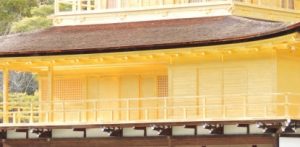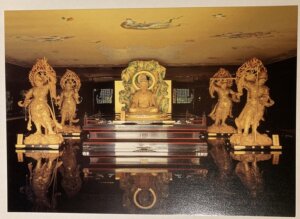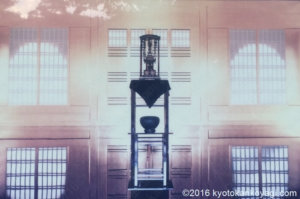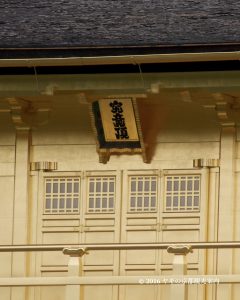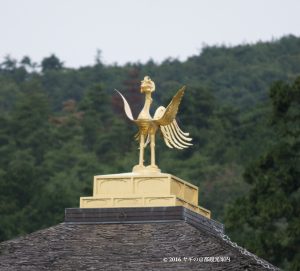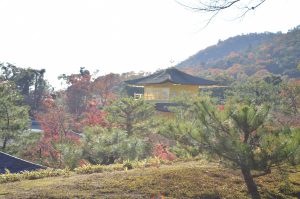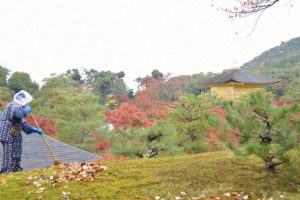THE GIST OF THIS ARTICLE
- Page 1 Introduction, About Kinkakuji, the golden pavilion (Shariden), the 1st floor.
- Page 2 The 2nd floor, the 3rd floor, the way to admire Sahriden
- Page 3 The prolific garden, night illumination on post card
- Page 4 Other Must-sees
- Page 5 Autume leaves and snow, access, etc.
The following is the contents of this article.
Chyo-on-doh, the 2nd floor 第二層 潮音洞
The 2nd floor is called “Chyo-on-doh”. It was built in the “Buke-zukuri” fashion, the style of the residence for the warriors. The door called “Maira-do”, the sliding door. It is so light that warriors can open it easily. It is suitable for warriors because they have to get out of their room with their swords right away when the enemy break into their residence.
Inside of it, there are statues of Kannon and her guardians. The word “Chyo-on-doh” means “the echo of the truth”. By the end of 19th century, there used to be a bridge between Shairden and a facility located near.

Ruriden of Saihoji used to have the same construction.
Kuttu-kyo-cho, the 3rd floor 第三層 究竟頂
The 3rd floor is called “Kukkyo-cho”. It was in the “Zensyu-butsuden-zukuri” fashion, the style of Zen temples. “Katoh-mado” window is a typical style of “Zensyu-butsuden-zukuri”. In side of it, the walls, pillars and ceiling are covered with gold sheets and the floor was lacquered the “Urushi”, the Japanese traditional lacquer.

A craftsman put about 3,000 sheets of gold on the ceiling in 1 day.
In the small shrine in the photo, there are “Busshari,” the ashes of Siddhartha Gautama.

I suppose the ashes are not the authentic one. They must be stones as the ones in Horyuji temple. Many Buddhist temples have Busshari.
“Kyttu-kyo-cho” means “Supreme” in Buddhism. The Kanjis on “Hengaku (the board the Kanji is written on)” were written by emperor Gokomatsu in the 14th century.

It is a replica. The authentic one was lost.
At the top of the roof, there a statue of “Ho-oh” (something like Phoenix). It is an imaginary sacred bird and stands for power and eternity.
Fortunately, the Hengaku and statue also escaped the fire in 1950 because they were repaired in a workshop.

The statue of Ho-oh was an only thing that has stood of the test of time. Its tail was broken and in need to be repaired. The one on the roof is a replica and the authentic one is stored in some place.
In Kukkyo cho, Statues of Buddhist deities used to be enshrined.

Ashikaga Yoshimasa, the founder of Ginkakuji temple, said he didn’t find them in 1485.
Did the construction of Sahriden represent Japanese society?
As we discussed, Sahriden has 3-story pavilion and each floor has different style. It is believed that the intention of Yoshimitsu’s is to show his ideal hierarchy in Japan. Top is Zen Buddhism (He was a great advocator of Zen), the second is the warrior class he belong to, and the third is the court nobles on the decline.
How do we enjoy “Shariden” ?
Shariden on “Mizukagami” (水鏡)
“Mizukagami” means “the mirror on the water”. We consider a surface of pond as a mirror, and enjoy the reflection on it. That’s the way we admire something beautiful like autumn leaves.

The Mizukagami of Kinkakuji.
Turning around to “Kinkaku” (見返り金閣)
We can have a amazing back view of Shariden. It seems as if it was floating around the clouds of green (in fall, red and vermilion) !


